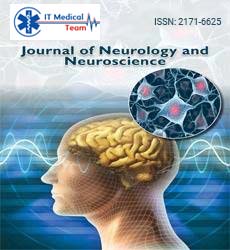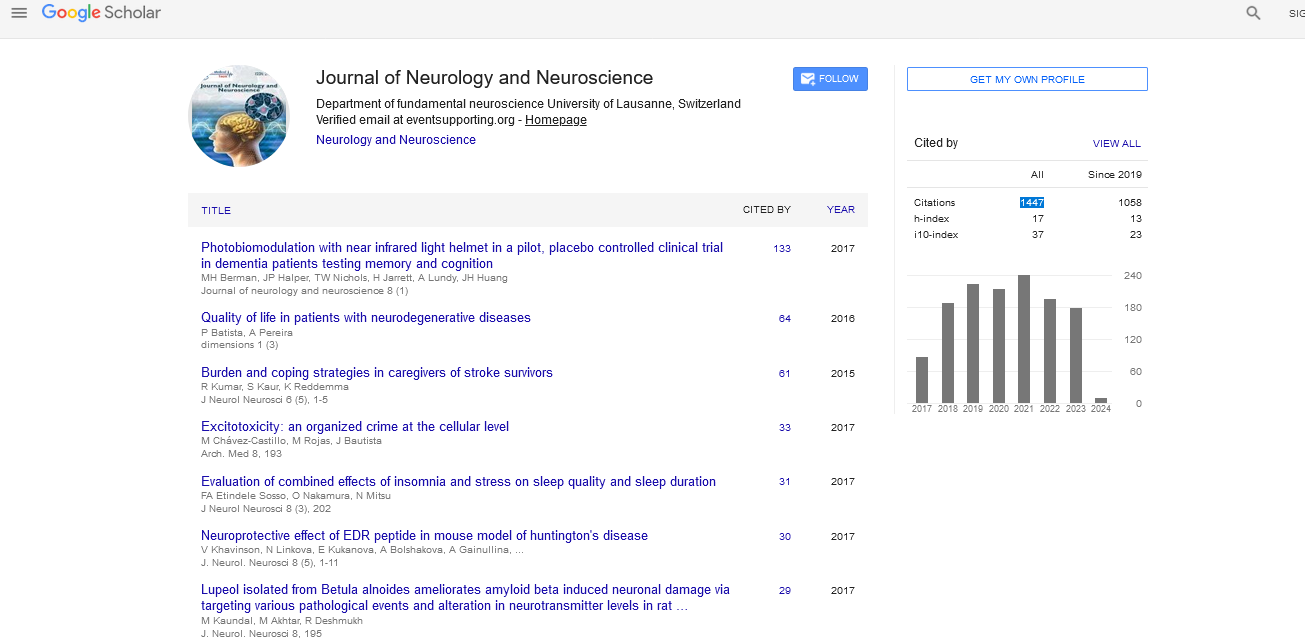Mini Review - (2024) Volume 15, Issue 2
Rodent Models of Huntington's Disease: An Overview
Gallilio Fernadez*
Department of Medicinal and Health Products Sciences, University of Camerino, Camerino, Italy
*Correspondence:
Gallilio Fernadez, Department of Medicinal and Health Products Sciences, University of Camerino, Camerino,
Italy,
Email:
Received: 01-Apr-2024, Manuscript No. ipjnn-24-14915;
Editor assigned: 03-Apr-2024, Pre QC No. P-14915;
Reviewed: 15-Apr-2024, QC No. Q-14915;
Revised: 22-Apr-2024, Manuscript No. R-14915;
Published:
29-Apr-2024
Abstract
Huntington's Disease (HD) is a progressive neurodegenerative disorder
characterized by motor dysfunction, cognitive decline, and psychiatric
symptoms. It is caused by a genetic mutation that leads to an abnormal
expansion of CAG repeats in the Huntingtin (HTT) gene, resulting in an
expanded polyglutamine tract in the huntingtin protein. This mutation
induces a cascade of cellular dysfunctions culminating in the death
of specific neuronal populations, predominantly in the striatum and
cortex. While human studies provide critical insights, animal models,
particularly rodent models, have been invaluable for understanding the
pathophysiology of HD and for developing therapeutic strategies.
Keywords
Disease; Huntingtin; Neuronal; Striatum; Cascade;
Young; Pathophysiology
Introduction
Rodent models offer several advantages for studying HD.
They have relatively short lifespans, allowing researchers to
observe disease progression and therapeutic outcomes within
a reasonable timeframe. Their brains, though simpler, share
fundamental similarities with human brains, making them useful
for studying neurodegenerative processes. Additionally, the ability
to manipulate the rodent genome enables the creation of precise
genetic models that replicate key aspects of human HD pathology.
Rodent models of HD can be broadly categorized into genetic
models, transgenic models, and chemically induced models.
Each type has its unique features and contributes differently to
our understanding of HD. Genetic rodent models involve the
introduction of human HD mutations into the rodent genome,
usually through knock-in or knock-out techniques. These models
are particularly valuable for studying the genetic and molecular
mechanisms underlying HD.
Knock-in models involve inserting a fragment of the human
HTT gene containing the expanded CAG repeats into the rodent
genome. These models closely mimic the genetic mutation seen
in human HD patients. These mice carry 150 CAG repeats in the
endogenous mouse Htt gene. They exhibit age-dependent motor
deficits, progressive striatal atrophy, and formation of nuclear
inclusions containing mutant huntingtin protein, mirroring the
human disease [1].
Literature Review
Knock-out models involve the deletion of the endogenous
rodent Htt gene. These models help in understanding the normal
function of huntingtin protein and the consequences of its loss.
Complete deletion of the Htt gene results in embryonic lethality,
highlighting the essential role of huntingtin in development.
Conditional knock-out models, where Htt is deleted in specific
tissues or at specific developmental stages, provide insights into
huntingtin's functions in adults and its role in specific cell types.
Transgenic models involve the introduction of mutant human
HTT transgenes into the rodent genome. These models can
express full-length or truncated versions of the human HTT gene
with expanded CAG repeats, allowing for the study of mutant
huntingtin protein's effects [2].
One of the most widely used HD models; R6/2 mice express
exon 1 of the human HTT gene with approximately 150 CAG
repeats. They exhibit rapid and severe disease progression, with
motor deficits, weight loss, and early death. These mice are
valuable for studying early and aggressive forms of HD and for
testing potential therapies. These mice carry a yeast artificial
chromosome containing the entire human HTT gene with 128
CAG repeats. They show progressive motor and cognitive deficits,
striatal atrophy, and inclusion formation. The YAC128 model is
particularly useful for studying the full-length mutant huntingtin
protein's effects and for long-term therapeutic studies.
Discussion
These mice express a truncated version of the human HTT
gene containing the first 171 amino acids with 82 CAG repeats.
They develop motor deficits, weight loss, and inclusion bodies.
This model is useful for studying the role of specific huntingtin
fragments in HD pathogenesis. These transgenic rats express
a truncated human HTT gene with 51 CAG repeats. They
exhibit motor deficits, cognitive impairments, and striatal
atrophy. The larger size of rats compared to mice allows for more
detailed behavioural and neuroanatomical studies. Chemically
induced models use neurotoxins to selectively destroy specific
neuronal populations, mimicking the neurodegeneration seen
in HD. These models do not replicate the genetic basis of HD
but are useful for studying disease mechanisms and testing
neuroprotective therapies. 3-NP is a mitochondrial toxin that
selectively targets striatal neurons, leading to neurodegeneration
and motor deficits similar to those observed in HD. This model
is used to study the role of mitochondrial dysfunction in HD
and to test potential neuroprotective agents. QA is an excitotoxin
that induces excitotoxic damage in the striatum, replicating the
excitotoxicity observed in HD. This model is useful for studying
the involvement of excitotoxic mechanisms in HD and for
evaluating anti-excitotoxic therapies.
Mutant huntingtin protein with expanded polyglutamine
tracts tends to misfold and aggregate, forming intracellular
inclusions. These aggregates are a hallmark of HD pathology
and are observed in various rodent models, including R6/2
and YAC128 mice. Studies have shown that these aggregates
disrupt normal cellular functions, including protein degradation
pathways, transcription, and mitochondrial function. Mutant
huntingtin interacts with various transcription factors, altering
the expression of numerous genes. Rodent models, particularly
full-length transgenic models like YAC128 mice, have revealed
widespread transcriptional dysregulation in the brain, affecting
genes involved in synaptic function, energy metabolism, and
stress responses. These findings suggest that transcriptional
dysregulation is a critical component of HD pathogenesis.
Mitochondrial abnormalities are prominent in HD and
have been extensively studied in rodent models. Models such
as the 3-NP-treated mice exhibit mitochondrial dysfunction,
including impaired respiration, reduced ATP production, and
increased oxidative stress. These findings support the hypothesis
that mitochondrial dysfunction contributes to neuronal
degeneration in HD. Synaptic dysfunction is an early event in
HD pathogenesis. Rodent models, including R6/2 and YAC128
mice, exhibit synaptic deficits such as impaired synaptic plasticity,
reduced synaptic vesicle release, and altered neurotransmitter
receptor expression. These alterations precede neuronal loss and
are thought to contribute to the cognitive and motor deficits
observed in HD [3-5].
Rodent models have been instrumental in testing potential
therapeutic strategies for HD. Gene silencing approaches aim to
reduce the production of mutant huntingtin protein. Antisense
Oligonucleotides (ASOs) and RNA Interference (RNAi) have
shown promise in rodent models. For instance, ASOs targeting
the HTT mRNA have been effective in reducing huntingtin
levels and ameliorating disease phenotypes in R6/2 and
YAC128 mice. These approaches are now being translated into
clinical trials. HDAC inhibitors, which modulate transcription,
have shown neuroprotective effects in R6/2 mice by reducing
mutant huntingtin aggregation and improving motor function.
Compounds targeting mitochondrial dysfunction, such as
coenzyme Q10 and creatine, have been tested in rodent
models with some success in ameliorating motor deficits and
extending lifespan.Anti-inflammatory drugs, such as minocycline
and NSAIDs, have demonstrated efficacy in reducing
neuroinflammation and improving behavioral outcomes in HD
rodent models. Cell replacement strategies aim to replace lost
neurons with healthy ones. Transplantation of neural stem cells or
progenitor cells into the striatum of rodent models, such as QAlesioned
rats, has shown potential in restoring motor function and
reducing neurodegeneration. These studies provide a foundation
for developing cell-based therapies for HD.
No single rodent model fully recapitulates all aspects of
human HD. Genetic models may not accurately represent the
complete spectrum of disease pathology, while transgenic models
often exhibit more rapid and severe phenotypes than those
observed in human patients. Chemically induced models do not
replicate the genetic basis of HD. Combining different models
and developing new ones that better mimic the human disease are
essential for advancing HD research. Despite promising results
in rodent models, translating these findings into effective human
therapies has been challenging. Differences in physiology, disease
progression, and drug metabolism between rodents and humans
can complicate translation. Rigorous preclinical testing and the
development of more predictive models are needed to improve
the success rate of clinical trials [6].
Conclusion
Advances in gene editing technologies, such as CRISPR/
Cas9, hold promise for developing more accurate rodent models
and for potential gene therapies. Additionally, humanized rodent
models, which express human genes in a rodent background, may
provide more relevant insights into human HD pathology and
therapeutic responses. Understanding HD requires a multifaceted
approach, integrating genetic, molecular, cellular, and behavioral
studies. Combining rodent models with other experimental
systems, such as patient-derived Induced Pluripotent Stem
Cells (iPSCs) and organoids can provide a more comprehensive
understanding of HD and facilitate the development of effective
therapies. Rodent models have been indispensable in advancing
our understanding of Huntington's disease. They have provided
critical insights into the genetic, molecular, and cellular
mechanisms underlying HD and have been instrumental in
testing potential therapeutic strategies. While challenges remain
in translating these findings into human therapies, ongoing
advancements in model development and emerging technologies
hold promise for overcoming these obstacles. The continued use
of rodent models, alongside other experimental systems, will be
crucial in the quest to develop effective treatments and ultimately
a cure for Huntington's disease.
Acknowledgement
None.
Conflict of Interest
None.
References
- Cepeda C, Levine MS. Synaptic dysfunction in huntington’s disease: Lessons from genetic animal models. Neuroscientist. 2022; 28(1):20-40.
Google Scholar, Crossref, Indexed at
- Jia Q, Li S, Li XJ, Yin P. Neuroinflammation in huntington’s disease: From animal models to clinical therapeutics. Front Immunol. 2022; 13:1088124.
Google Scholar, Crossref, Indexed at
- Walker FO. Huntington's disease. Lancet. 2007; 369(9557):218-228.
Google Scholar, Crossref, Indexed at
- Baliko L, Csala B, Czopf J. Suicide in hungarian huntington’s disease patients. Neuroepidemiology. 2004; 23(5):258-260.
Google Scholar, Crossref, Indexed at
- Robins Wahlin TB, Bäckman L, Lundin A, Haegermark A,et al. High suicidal ideation in persons testing for huntington's disease. Acta Neurol Scand 2000; 102(3):150-161.
Google Scholar, Crossref, Indexed at
- Macdonald V, Halliday G. Pyramidal cell loss in motor cortices in Huntington's disease. Neurobiol Dis. 2002 Aug 1; 10(3):378-86.
Google Scholar, Crossref, Indexed at





